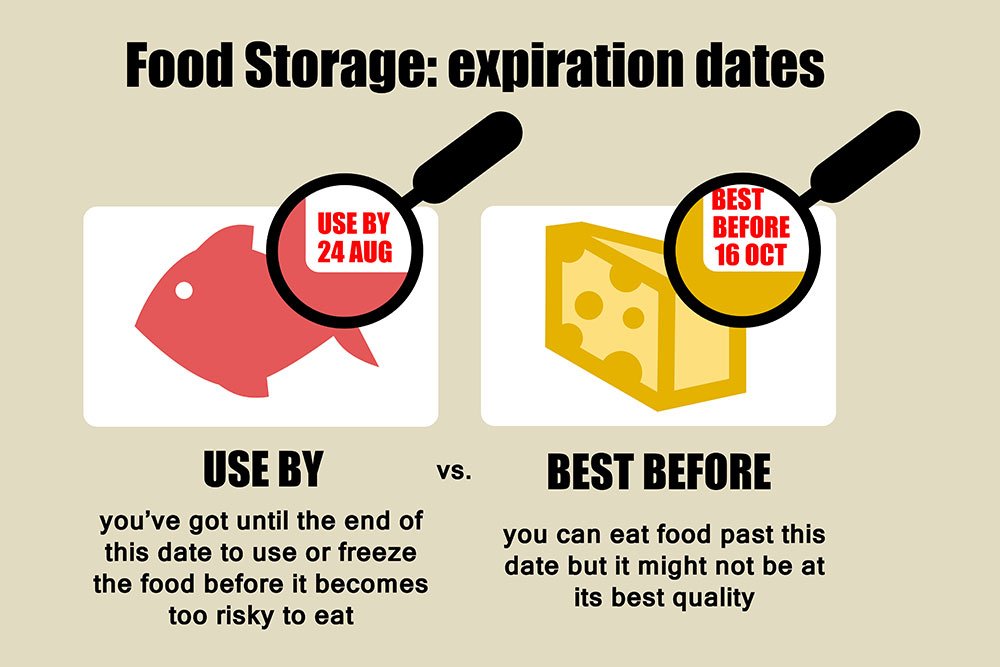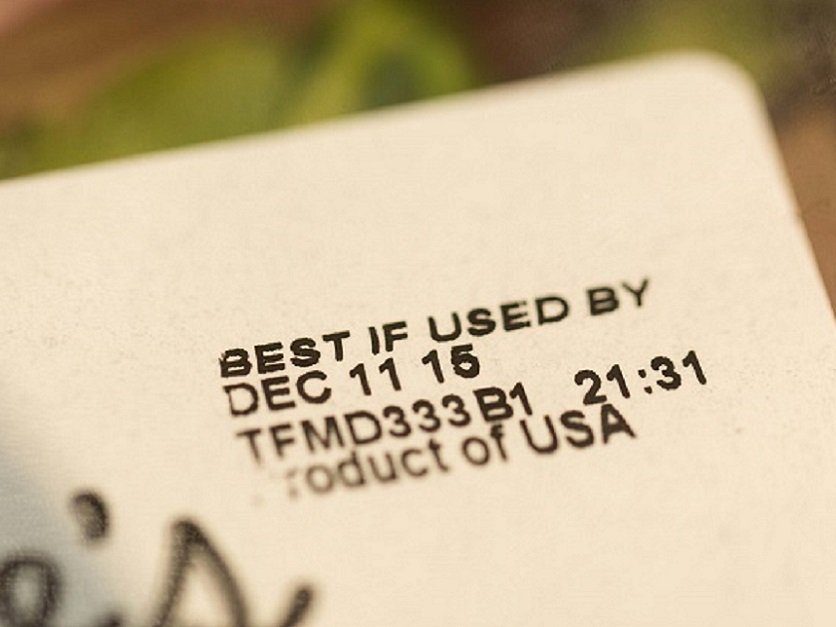What Do Best By, Sell By, and Use By Dates Really Mean?
To aid retailers and consumers in understanding the current condition of a food item, producers include date labels on the packaging.
However, some consumers continuously end up with spoiled food supplies due to the ongoing confusion with these food labels. So what do “best-by,” “sell-by,” and “use-by” dates mean?
Continue reading to understand the differences between best-by, sell-by, and use-by dates, as well as all relevant information about label dates that can help prevent food waste.
Defining Best-By, Sell-By, & Use-By Date
Best-By
Best-by dates refer to the date printed on a food packaging that indicates when it should maintain its peak quality. It is not a purchase or safety date; this date tells when a food product should be consumed or used for the best quality.
Foods that are days past best-by dates are generally safe to eat, but the quality and texture may have declined.
Sell-By
Sell-by dates refer to the date printed on food packaging that indicates the date recommended by the manufacturer for retailers to sell the product.
It is not a purchase or safety date and is primarily intended for inventory management in grocery stores.
Foods that are days past sell-by dates are generally safe to eat, but the quality and flavor may have declined.
Use-By Date
Use-by dates are not expiration dates and refer to the date printed on food packaging that indicates the last date by which perishable products should be used or consumed for food safety reasons.
Foods with past use-by dates are no longer safe to eat, and some health risks are associated.
How to Know When to Eat or Toss Food
Produce
Fresh produce should feel firm, have vibrant color, a fresh aroma, and no signs of wilting, damage, or bruising.
You’ll know if produce is spoiled or past its prime if it feels soft or mushy, has a faded or dull color, has a bad smell, is wilted, and has cuts.
Poultry
Poultry products, including egg products, usually have a pack date and stamp of USDA grade shield, both of which you should look for. The meat should also have a pink or light beige color.
“We should all grow our own food and do our own waste processing, we really should.”
— Bill Gates, American Business Magnate, Investor, Philanthropist, and Writer
You must toss it if it gives off a rancid odor, slimy texture, mold, or discoloration in which the meat appears gray or greenish.
Dairy
Check the printed date on dairy products, which is usually the sell-by and use-by dates. Also, you will determine they’re all right when they have a smooth and creamy texture.
If the product looks or smells sour or unusual or shows signs of spoilage, such as mold, discoloration, or an off-putting smell, it’s best to discard it.
Pasta & Grains
You will know if these products are still good to eat if the pasta is firm and the grains are uniform in color and shape.
If the product has signs of pests or insects, such as small holes in the packaging, or has a rancid odor, it’s best to toss it.
Canned & Boxed Foods
Most shelf-stable products, like canned products and boxed foods, usually have product dates to which you can refer in determining their freshness.
If there are any dents, rust, or swelling on canned foods and damages, bulges, or leaks on boxed foods, it’s time to toss them.
Difference Between Sell-By Date & Best-By Date

Sell-by date indicates when a product should be sold by the retailer, whereas the best-by date indicates when a product will stay fresh or have the best flavor or quality.
However, both dates aim to provide consumers with a better understanding of a product’s food quality, albeit through distinct methods.
Does the Law Require Food Product Dating?
No federal regulations require food dating for other products, though manufacturers may voluntarily choose to include a food label.
However, federal law or The Food Safety and Inspection Service (FSIS) requires food dating for infant formula or baby formula [1].
This date ensures that the formula is of its best quality and nutrition while promoting the safety and well-being of infants or babies.
How Do Manufacturers Determine the Quality Dates?
Manufacturers use various methods to determine the quality dates of food products, including accelerated shelf-life testing, real-time shelf-life testing, statistical analysis, packaging and storage studies, microbiological challenge studies, and field studies.
Manufacturers may also consult with food scientists, regulatory agencies, and industry standards organizations to ensure their quality dates align with the best practices and legal requirements.
Are Foods Safe to Eat After the Product Date Passes?
Generally, eating a food after its product date has passed may not be harmful as long as it shows no signs of spoilage, such as off odor, an off flavor, or visible mold growth.
However, if a product develops unpleasant characteristics or shows signs of food spoilage, it should be handled properly and discarded.
It depends on several factors, including the type of food, the storage conditions, and the specific product date in question.
What Do Can Codes Mean?
Can codes are a combination of letters and numbers stamped on canned goods to help manage inventory and track products intended for manufacturers.
These codes also identify the date the product was canned and when it should be consumed to avoid food waste.
However, the format varies and is not standardized among several manufacturers.
If there are no codes in your purchased canned goods, you can mark them with your purchase date instead to estimate their freshness, though canned products generally have a shelf life of at least two years.
Tips & Tricks to Extend Shelf Life of Foods
- Keep food items frozen to maintain peak quality, especially fresh beef, ground meat, fruits, and vegetables, stored in freezer-safe containers or bags.
- Avoid leaving foods at room temperature for more than two hours to reduce the risk of bacterial growth and prevent spoiled foods.
- Ensure foods like meats, dairy products, and produce are stored properly in the refrigerator. Store dry goods, such as grains and beans, in a cool, dry place.
FAQs on Best By, Sell By, and Use By Dates
What types of food are dated?
Food products (fresh meat, poultry, and dairy), packaged foods (canned, dry, and frozen goods), infant formula, and ready-to-eat foods (salads or sandwiches) can all be dated.
How long is food good after the sell-by date?
Many food items are generally safe to consume after the sell-by date has passed, especially if properly stored—even if it’s weeks past, as long as there are no visible spoilage bacteria.
Can you drink water after the best-by date?
Yes, water is generally safe to drink after its best-by date, as long as it was not exposed to contaminants and has been appropriately
However, the plastic bottle from which the water comes has an expiration date, and drinking water from a bottle beyond its expiration date is not a good idea since the plastic can leach into the water over time.
Does best before mean expired?
No, the term best-before is not an expiration date but refers to the date until which the manufacturer expects it to retain its peak quality, flavor, and
After the best-before date has passed, the product may not be at its optimal quality and is not often deemed as expired food. In most cases, it can still be safe to consume.
Conclusion
Food product dating is an essential tool that helps retailers and consumers identify the freshness and quality of food products they store or purchase.
However, product dates are not always a guarantee of safety but rather serve as a helpful guide only for retailers and consumers.
Therefore, it is crucial to properly store and handle food items in the right conditions to extend their shelf life and reduce the risk of foodborne illness.
References:
- https://ucanr.edu/sites/letseathealthy/newsletters/Food_Safety_Update67654.pdf
- https://www.healthline.com/nutrition/does-water-expire#bottled-water

Kathy is a restaurateur, artist, and blogger. After spending more than 10 years in the restaurant industry, she has decided to go digital and share her expertise and experience online.







